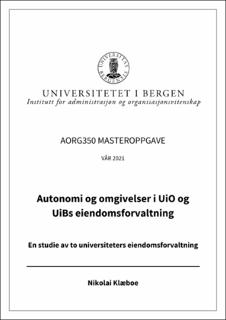| dc.contributor.author | Klæboe, Nikolai | |
| dc.date.accessioned | 2021-07-27T23:51:44Z | |
| dc.date.available | 2021-07-27T23:51:44Z | |
| dc.date.issued | 2021-07-01 | |
| dc.date.submitted | 2021-07-27T22:00:07Z | |
| dc.identifier.uri | https://hdl.handle.net/11250/2765415 | |
| dc.description.abstract | Universitetenes autonomi vil være preget av rammene og handlingsrommet som og rammene som omgivelsene gir dem. Dette gjelder også i eiendomsforvaltningen. I dag er det en todelt løsning hvor noen institusjoner innenfor høyere utdanning forvalter eiendom selv på vegne av staten, deriblant universitetene i Oslo (UiO) og Bergen (UiB), mens andre har Statsbygg som forvalter. I 2019 ble eiendomsforvaltning et tema for konflikt etter en statlig områdegjennomgang. Den anbefalte at ordningen med selvforvaltende institusjoner ble avviklet- og at forvaltningsansvaret ble overført til Statsbygg. Dette satte universitetenes eiendomsforvaltning på agendaen og en konflikt utspilte seg. Denne oppgaven handler universitetenes autonomi og samspill med universitetenes omgivelser. Blant universitetene er UiO og UiB som undersøkes. Den konkrete undersøkelsen konsentrerer seg som disse universitetets fysiske rom og hus – deres eiendomsforvaltning. Valget bygger på at det å kunne ha råderett over fysiske strukturerer og rammer anses som et viktig element i begrepet om universitetenes autonomi. UiO og UiBs strategiske planer for eiendom og deres større historiske utbyggingsprosesser undersøkt og sammenlignet i en komparativ casestudie, i tillegg er det gjort en prosesstudie av endringer i den statlige styringen av universitetenes forvaltning av eiendommer og fysiske rom. UiO og UiB er de to eldste institusjonene i landet og de er ganske like som bredde- og forskningsuniversitet, samtidig som UiO er omtrent dobbelt så stort som UiB. Begge har relativt likt system for sin eiendomsforvaltning, og de har samme typer av rammebetingelser og relasjoner til de samme aktørene i sin eiendomsforvaltning. I denne studien vises det at institusjonene hadde en mer instrumentell tilnærming til sine omgivelser tidligere. I dag ses det mer dynamiske relasjoner og universitetene leter etter aktører som kan hjelpe til med å utføre kjernevirksomheten, samtidig som de operer innenfor en regulert sektor. Staten er den viktigste samhandlingsaktøren med finansiering, regulerende myndighet og ulike typer styringstiltak. Staten legger føringer for hvordan institusjonene skal drive sin virksomhet, samtidig som universitetene forholder seg til en rekke andre aktører på områder hvor de kan bruke sin autonomi. Både UiO og UiB bruker den autonomien de har i sin eiendomsforvaltning til å styrke sin egen kjernevirksomhet, i tillegg har de fokus på miljø- og bærekraft. De bruker også sin autonomi for å finne løsninger som kan øke det økonomiske handlingsrommet. Samtidig bruker institusjonene sin statsbevilgning til planmessig vedlikehold av en stor og eldre eiendomsmasse som er kostbar å holde i dagens stand. | |
| dc.description.abstract | The universities’ autonomy will be shaped by the room that the institutional environment provides for the institutions to manoeuvre in. This also applies to property management. In Norway today, there is a two-part solution where some institutions within higher education manage property themselves on behalf of the state, including the universities of Oslo (UiO) and Bergen (UiB), while others have Statsbygg as their manager. In 2019, property management became a topic of conflict after an administrative efficiency area review. It was recommended that the management responsibility was transferred to Statsbygg. This put the universities’ property management on the agenda and a conflict unfolded. This thesis focuses on the universities’ autonomy and the environments of the universities. UiO and UiB are analysed. This specific study focuses on these universities’ property management. The choice of topic is based on property management as a key element in the universities’ autonomy. UiO and UiB's strategic plans for property and their major historical development processes have been analysed and compared in a comparative case study. In addition, a process study has been conducted to study changes in the state authorities’ regulation of the universities’ management of properties. UiO and UiB are the two oldest institutions in Norway. They are research universities and have many similarities, but UiO is approximately twice as large as UiB. Both have relatively similar systems for their property management, and they have the same relationships with the actors affecting their property management. This study shows that the institutions had a more instrumental approach to their environments in the past. Today, more dynamic relationships are common, and universities are looking to cooperate with actors who can help them carry out their core activity, while at the same time operate within a regulated sector. The state is the most important actor in terms of financing, regulatory authority, and various types of management measures. The state provides guidelines for how the institutions are to conduct their activities, at the same time as the universities relate to several other actors in areas where they can use their autonomy. Both UiO and UiB use the autonomy they have in their property management to strengthen their own core activity; in addition, they focus on environmental sustainability. They also use their autonomy to find solutions that results in additional funding. At the same time, the institutions use their funds on maintenance of a large, and old, property portfolio that is costly to maintain. | |
| dc.language.iso | nob | |
| dc.publisher | The University of Bergen | |
| dc.rights | Copyright the Author. All rights reserved | |
| dc.subject | UiB | |
| dc.subject | universiteters omgivelser | |
| dc.subject | UiO | |
| dc.subject | Eiendomsforvaltning i høyere utdanning | |
| dc.subject | universiteters autonomi | |
| dc.title | Autonomi og omgivelser i UiO og UiBs eiendomsforvaltning | |
| dc.title.alternative | Autonomy and Institutional Environments in UiO and UiB's property management | |
| dc.type | Master thesis | |
| dc.date.updated | 2021-07-27T22:00:07Z | |
| dc.rights.holder | Copyright the Author. All rights reserved | |
| dc.description.degree | Masteroppgave i administrasjon og organisasjonsvitenskap | |
| dc.description.localcode | AORG350 | |
| dc.description.localcode | MASV-AORG | |
| dc.subject.nus | 731111 | |
| fs.subjectcode | AORG350 | |
| fs.unitcode | 15-12-0 | |
